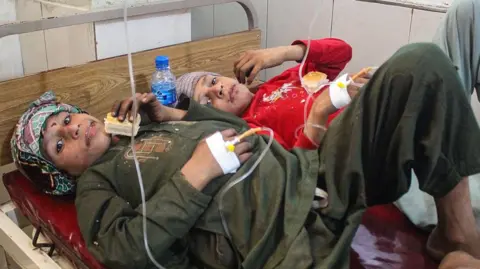At least 800 dead after 6.0-magnitude quake flattens Afghan villages
Survivors in eastern provinces say they were 'covered in dust' as remote, mountainous terrain and collapsed homes compound the humanitarian crisis
A powerful earthquake measuring 6.0 struck eastern Afghanistan just before midnight on Sunday, killing at least 800 people and flattening homes in remote mountain communities, the United Nations said.
The quake’s impact was greatest in Nangarhar and Kunar provinces, but it was felt as far away as the capital, Kabul, and in neighbouring Pakistan’s Islamabad. Residents in several hard-hit villages described scenes of widespread destruction, panic and makeshift burials.
Matiullah Shahab, a freelance journalist and human rights activist from the town of Asadabad in Kunar, said he woke to find his house shaking and fled outside with 23 family members who live with him. “We were all afraid,” he said. After daybreak he drove toward the remote area near the quake’s epicentre to help, and assisted in digging graves in the village of Andarlachak Tangi, one of the communities hit by the tremors.

Witnesses described streets and homes blanketed in dust, with many residents too shocked to speak. Authorities and aid groups have warned that the remote, mountainous terrain in the affected areas is likely to complicate rescue and relief operations. Initial reports indicated numerous buildings had collapsed, forcing survivors to sleep outdoors for fear of aftershocks.
The UN toll is preliminary and could rise as rescuers reach isolated settlements. Communications and transport links in parts of eastern Afghanistan are routinely constrained, and winter temperatures in mountain districts can increase risks for people left homeless.
Local volunteers, journalists and residents were among the first to search for survivors and recover the dead, digging graves where cemetery space or transport was limited. Hospitals in nearby towns reported receiving large numbers of injured people, though detailed, independently verified counts of casualties and damage were not immediately available.
The quake’s epicentre was located about 16 kilometres (10 miles) from some of the affected villages, according to local accounts, and aftershocks were reported in the hours following the main shock. Aid agencies and governments often mobilise emergency response teams after major quakes in Afghanistan, but access and security conditions can delay the delivery of supplies, shelter and medical care.

Authorities and aid organisations were due to assess needs and coordinate relief efforts as daylight allowed rescuers to reach more remote settlements. The full humanitarian impact will depend on how quickly emergency teams can gain access to mountain districts and provide shelter, medical assistance and other basic services to survivors.
The United Nations and local officials provided the initial fatality figure; further updates were expected as rescue operations continued and more communications were restored in isolated areas.